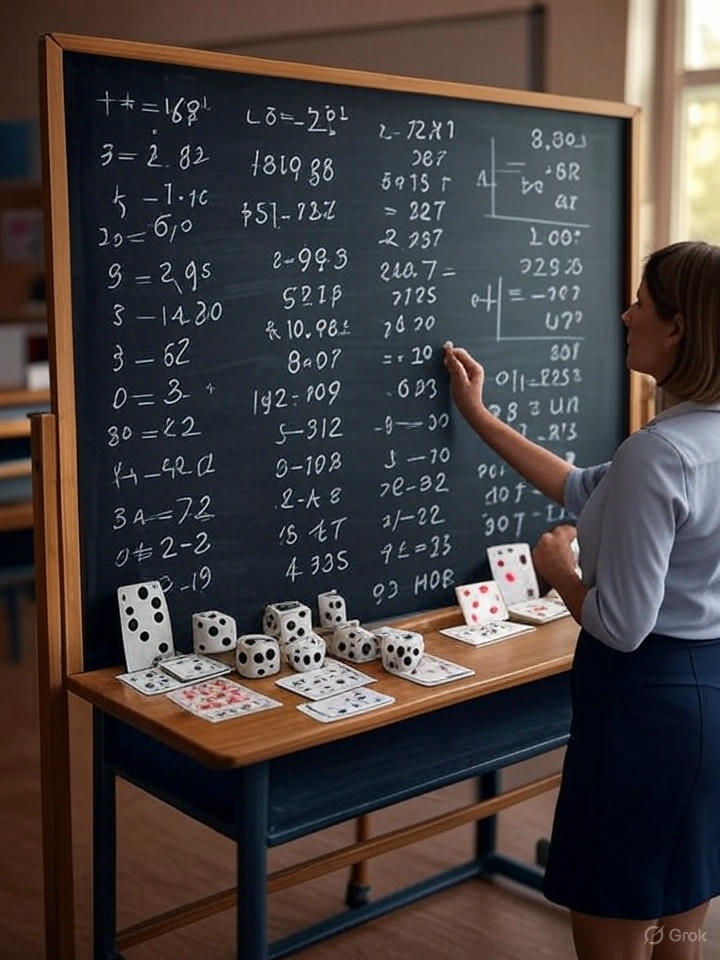What is the Definition of Probability?
The definition of probability is a measure of how likely an event is to occur, expressed as a number between 0 and 1, where 0 indicates impossibility and 1 indicates certainty. In my years of exploring statistics, I’ve found probability to be a powerful tool for quantifying uncertainty. For instance, when I flip a coin, there’s a 50% chance or a probability of 0.5 that it will land on heads. This concept is foundational in fields like data science, finance, and even game theory.
Probability is calculated as the ratio of favorable outcomes to the total number of possible outcomes, assuming all outcomes are equally likely. The basic probability formula is:
P(A) = Number of favorable outcomes / Total number of possible outcomes
For example, when rolling a six-sided die, the probability of rolling a 3 is 1/6, as there’s one favorable outcome (rolling a 3) out of six possible outcomes (1, 2, 3, 4, 5, or 6).
What is Basic Probability?
Basic probability, often referred to as theoretical probability, deals with events where outcomes are equally likely, such as rolling a die or flipping a coin. It’s the starting point for understanding more complex probability concepts. Let me share a simple way to think about it: basic probability is like predicting the odds in a fair game.
The basic probability formula, as mentioned earlier, is:
P(A) = Number of favorable outcomes / Total number of possible outcomes
To make this clearer, here are three examples to understand basic probability:
- Drawing a red card from a deck: A standard deck has 52 cards, with 26 red cards (hearts and diamonds). The probability of drawing a red card is 26/52 = 1/2 or 0.5.
- Rolling an even number on a die: A six-sided die has three even numbers (2, 4, 6). The probability is 3/6 = 1/2 or 0.5.
- Choosing a vowel from the alphabet: There are 26 letters, with 5 vowels (a, e, i, o, u). The probability is 5/26 ≈ 0.192.
These examples illustrate how basic probability relies on a clear understanding of the sample space the set of all possible outcomes.
What are the Types of Probability?
The types of probability include classical, empirical, subjective, and axiomatic. Each type approaches the concept differently, and I’ve found that understanding these distinctions is key to applying probability effectively in various contexts. Below, I’ll name and explore each type in detail.
- Classical Probability
- Empirical Probability
- Subjective Probability
- Axiomatic Probability
Let’s break down each one.
What is Classical Probability?
Classical probability, also known as theoretical or a priori probability, assumes that all outcomes in a sample space are equally likely. It’s the type of probability I first encountered when learning about dice rolls and card games in school. It’s calculated using the basic probability formula:
P(A) = Number of favorable outcomes / Total number of possible outcomes
For example, the probability of rolling a 4 on a six-sided die is 1/6, as there’s one favorable outcome out of six possible ones.
Here are three examples to understand the concept of classical probability:
- Drawing an ace from a deck: There are 4 aces in a 52 card deck, so the probability is 4/52 = 1/13 ≈ 0.077.
- Flipping two heads in a row: When flipping a coin twice, the sample space is {HH, HT, TH, TT}. The probability of two heads (HH) is 1/4 = 0.25.
- Picking a blue marble: If a bag contains 3 blue and 2 red marbles, the probability of picking a blue marble is 3/5 = 0.6.
Classical probability is ideal for scenarios with well-defined, equally likely outcomes, like games of chance.
What is Empirical Probability?
Empirical probability, sometimes called experimental probability, is based on observed data from experiments or real world events. I often use empirical probability when analyzing trends, such as predicting the likelihood of rain based on historical weather data. It’s calculated as:
P(A) = Number of times event A occurs / Total number of trials
For instance, if I flip a coin 100 times and get heads 52 times, the empirical probability of heads is 52/100 = 0.52.
Here are three examples to understand the concept of empirical probability:
- Defective products in a factory: If 10 out of 200 products are defective, the empirical probability of picking a defective product is 10/200 = 0.05.
- Rainy days in June: If it rained on 12 out of 30 days last June, the empirical probability of rain on a June day is 12/30 = 0.4.
- Successful free throws: If a basketball player makes 80 out of 100 free throws, the empirical probability of making a free throw is 80/100 = 0.8.
Empirical probability is practical for real world scenarios where outcomes aren’t necessarily equally likely.
What is Subjective Probability?
Subjective probability is based on personal judgment, intuition, or expertise rather than precise calculations or data. As someone who’s made countless decisions under uncertainty, I find subjective probability fascinating because it reflects human reasoning. There’s no fixed formula, as it depends on an individual’s belief about the likelihood of an event.
For example, I might estimate a 70% chance that my favorite team will win a match based on their recent performance and my gut feeling.
Here are three examples to understand the concept of subjective probability:
- Startup success: An investor might assign a 30% probability to a startup’s success based on the team’s experience and market trends.
- Job offer acceptance: A recruiter might estimate a 60% chance that a candidate will accept a job offer based on their enthusiasm during the interview.
- Flight delays: Based on past experiences, I might believe there’s a 40% chance my flight will be delayed during the holiday season.
Subjective probability is useful when data is scarce or events are unique, but it’s inherently less precise.
What is Axiomatic Probability?
Axiomatic probability provides a formal, mathematical framework for probability based on three axioms proposed by Andrey Kolmogorov. As a math enthusiast, I appreciate how this approach unifies probability theory. The axioms are:
- The probability of any event is a non-negative number: P(A) ≥ 0.
- The probability of the sample space (all possible outcomes) is 1: P(S) = 1.
- For mutually exclusive events A and B, the probability of their union is the sum of their probabilities: P(A ∪ B) = P(A) + P(B).
There’s no specific formula beyond these axioms, as they define the rules for all probability calculations.
Here are three examples to understand the concept of axiomatic probability:
- Rolling a die: The probability of rolling any number (1 to 6) is non-negative, and the sum of probabilities for all outcomes is 1 (1/6 + 1/6 + … = 1).
- Mutually exclusive events: If I can’t draw both a heart and a spade from a deck in one draw, the probability of drawing either is P(heart) + P(spade) = 13/52 + 13/52 = 26/52 = 0.5.
- Impossible event: The probability of rolling a 7 on a six-sided die is 0, satisfying the non-negativity axiom.
Axiomatic probability is the theoretical foundation for all other types, ensuring consistency in calculations.
How to Calculate Probability?
Calculating probability depends on the type of probability and the context, but the general approach involves identifying the sample space, counting favorable outcomes, and applying the appropriate formula. Here’s a simple, step-by-step guide I’ve honed over years of teaching and applying probability:
- Define the event: Clearly state what you’re calculating the probability for (e.g., rolling a 5 on a die).
- Identify the sample space: List all possible outcomes (e.g., {1, 2, 3, 4, 5, 6} for a die).
- Count favorable outcomes: Determine how many outcomes match the event (e.g., one outcome for rolling a 5).
- Apply the formula: Use P(A) = Number of favorable outcomes / Total number of possible outcomes (e.g., 1/6 for rolling a 5).
- Simplify if needed: Express the result as a fraction, decimal, or percentage (e.g., 1/6 ≈ 0.167).
For more complex scenarios, you might use additional rules, like the addition rule for mutually exclusive events (P(A or B) = P(A) + P(B)) or the multiplication rule for independent events (P(A and B) = P(A) × P(B)).
For example, to calculate the probability of drawing a king or a queen from a deck:
- Kings: 4/52
- Queens: 4/52
- Since the events are mutually exclusive, P(king or queen) = 4/52 + 4/52 = 8/52 = 2/13 ≈ 0.154.
For more on calculating probability, check out our probability calculator.

